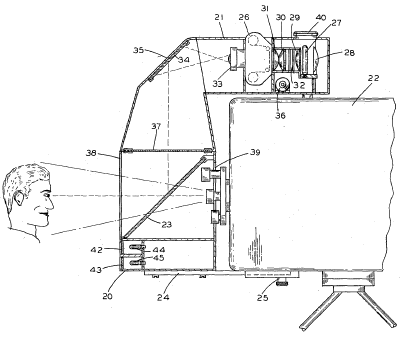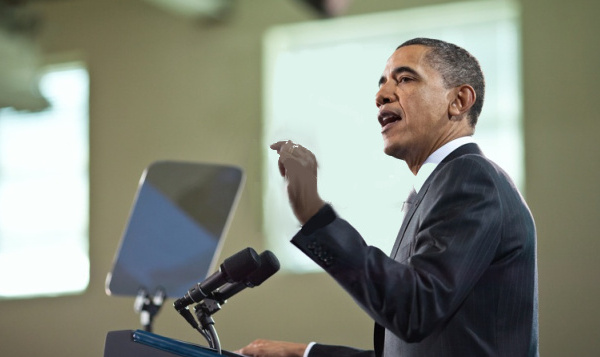The Teleprompter
June 8, 2011
Invention is a difficult thing in this high-tech world of
mobile computing devices. The invention process typically involves a huge and highly educated team of employees who are armed with rooms full of very expensive equipment.
In an earlier time, most inventions were
mechanical; and they were very simple, if only for the fact that it's difficult to make complex and reliable machines. I'm reminded of the
Veg-O-Matic commercials of my youth that ran on local
television stations long before
shopping channels appeared on
cable television.[1] "It slices! It dices! Isn't that amazing!" The Veg-O-Matic was invented by
Ron Popeil, who also gave us the memorable
Popeil Pocket Fisherman.
This was also the age of the
teleprompter, a mechanical-
optical device that mitigated a major problem of early television - the lack of
video recorders. Those were the days of incessant
soap operas that have been replaced today by incessant
talk shows. Everything was done live, and since such teleplays were done daily,
rehearsals were short and occasionally ineffective.
Actors and actresses would sometimes miss lines, and a scene was often saved only by an extemporaneous
monologue by another actor.[2]
A teleprompter solves the memorization problem by presenting the script on a viewing pane directly in front of the
camera. The mechanical teleprompter was patented by
Jess Oppenheimer, who was the producer of the "
I Love Lucy" television series.[3] Although the series was filmed, and the actors memorized their lines, it was still difficult for
Lucille Ball to memorize
commercials that she presented on-camera. The figure below shows the basic arrangement of Oppenheimer's teleprompter.

Fig. 3 of US Patent No. 2,883,902, "Prompting Apparatus." [3]
The optical element (23) is a
partially-silvered mirror that allows the camera lens a reasonably clear optical path to the performer. This mirror also reflects a projected image of the script that's penned on a transparent sheet of plastic not unlike
photographic film stock without an
emulsion. An arrangement of lenses ensures that the script image is properly displayed as it "crawls" from the bottom of the screen to the top.
Oppenheimer's patent was filed on October 14, 1954, but the company most often associated with this concept,
TelePrompTer, was founded at about the same time. The term, teleprompter, which describes the many variations of this concept, has become a
generic term. TelePrompTer was founded by Fred Barton Jr., Irving Berlin Kahn and
Hubert J. Schlafly. Schlafly, who invented variations of the teleprompter concept, along with other television-related inventions, including some for
satellite communications, died on April 20, 2011, at age 91.[4-7] Schlafly, who eventually became the president of TelePrompTer, accepted an
Emmy Award for the company in 1999.[4]
As technology evolved, so did the teleprompter. The most significant improvement was replacement of the script on transparency stock by a
computer display. Eventually, teleprompter systems became a staple on
podiums everywhere, where they made public speaking more oratorical and conversational. A teleprompter was used by
former US President Herbert Hoover at the 1952
Republican Party national convention.[4] Unfortunately, Hoover departed from the script in the middle of his speech, and there was some confusion before the teleprompter rolled again.[5]
Ubiquitous computing and inexpensive displays have allowed teleprompting to be incorporated into smaller public speaking sessions, such as church sermons. I'm still waiting for the
science fiction version, a teleprompter in a pair or eyeglasses or a
retinal display. It would help me remember the names of wives and children when I unexpectedly meet my former co-workers at the supermarket.

US President Barack Obama using a teleprompter during a speech (Fixing No Child Left Behind, March 14, 2011). (Still image from a White House video, modified).
Why would the author of a blog that publishes articles about
graphene,
thermodynamics and
quantum mechanics be interested in something as mundane as the teleprompter? The partially-silvered mirror is one of the most useful optical components. I worked on a team that developed a unique sensor that fired a light beam into free space and looked at the scattered light from the same direction. The optical circuit was exactly the same as the teleprompter, with a
light-emitting diode replacing the projector, and a
phototransistor replacing the camera.
What's past is prologue.
References:
- K-tel "Veg-O-Matic" commercial, via YouTube.
- One of my areas of expertise is the art of the soap opera. I sat through quite a few of these in 1967, when I had a summer job in a television station control room.
- J. Oppenheimer, "Prompting Apparatus," US Patent No. 2883902, April 28, 1959.
- Teleprompter inventor Hubert Schlafly dies at 91, BBC News, April 26, 2011.
- Emma Brown, "'Hub' Schlafly, TV engineer who helped invent teleprompter, dies at 91," Washington Post, April 25, 2011.
- Stephen Miller, "Hubert Schlafly 1919-2011 - Engineer's Device Eased Speechmakers' Minds," Wall Street Journal, April 26, 2011.
- David Cohen, "TelePrompTer inventor dies," Politico.com, April 26, 2011.
Permanent Link to this article
Linked Keywords: Invention; mobile computing device; mechanical; Veg-O-Matic; television station; shopping channel; cable television; Ron Popeil; Popeil Pocket Fisherman; teleprompter; optics; optical; video recorder; soap opera; talk show; rehearsal; actors and actresses; monologue; camera; Jess Oppenheimer; I Love Lucy; Lucille Ball; commercial; US Patent No. 2,883,902; partially-silvered mirror; photographic film stock; emulsion; TelePrompTer; generic; Hubert J. Schlafly; satellite communications; Emmy Award; computer display; podium; former US President Herbert Hoover; Republican Party; national convention; science fiction; retinal display; US President Barack Obama; graphene; thermodynamics; quantum mechanics; light-emitting diode; phototransistor; What's past is prologue.